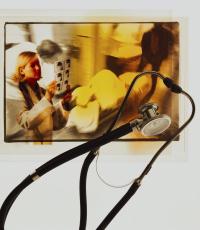 |
 |
 |
Other Health Topics:

-
Related Topics
-
Go Local
- Services and providers for Critical Care in the U.S.
-
People with life-threatening injuries and illnesses need critical care. Critical care involves close, constant attention by a team of specially-trained health professionals. It usually takes place in an intensive care unit (ICU) or trauma center. Problems that might need critical care treatment include complications from surgery, accidents, infections and severe breathing problems.
Monitors, intravenous (IV) tubes, feeding tubes, catheters, ventilators and other equipment are common in critical care units. These can sustain life but can also increase the risk of infection.
While patients may recover, death is a possibility for people in critical care. Communication with health care providers and family members is an important part of making end-of-life decisions.
-
JAMA Patient Page: Intensive Care Units(American Medical Association) - Links to PDF
Also available in Spanish
| Basics | Learn More | Multimedia & Cool Tools |
|---|---|---|
| Research | Reference Shelf | For You |
-
Overviews
- Critical Care Questions(Society of Critical Care Medicine)
- Primer on Critical Care for Patients and Their Families(American Thoracic Society)
-
Latest News
- Stress Disorder Affects 20% of Intensive Care Patients(09/17/2008, HealthDay)
- Findings Challenge Tight Glucose Control for Critically Ill Patients(08/26/2008, HealthDay)
-
Coping
-
Taking Care of Yourself While a Loved One Is in the ICU(Society of Critical Care Medicine)
Also available in Spanish
- When a Loved One Needs Critical Care(American Association of Critical-Care Nurses) - Links to PDF
-
Taking Care of Yourself While a Loved One Is in the ICU(Society of Critical Care Medicine)
-
Specific Conditions
- Adult (Acute) Respiratory Distress Syndrome (ARDS)(American Lung Association)
-
ARDS (Acute Respiratory Distress Syndrome)
 (National Heart, Lung, and Blood Institute)
(National Heart, Lung, and Blood Institute)
-
Common Problems of Critical Illness(Society of Critical Care Medicine)
Also available in Spanish
-
Sepsis: What You Should Know(Society of Critical Care Medicine)
Also available in Spanish
-
Related Issues
- Arterial Catheterization(American Thoracic Society) - Requires Flash Player
- Central Venous Catheterization (CVC)(American Thoracic Society) - Requires Flash Player
- Critical Care Team(Society of Critical Care Medicine)
-
Helpful Hospital Safety Tips(Society of Critical Care Medicine)
Also available in Spanish
- JAMA Patient Page: Ventilator-Associated Pneumonia(American Medical Association) - Links to PDF
-
Mechanical Ventilation(American Thoracic Society) - Requires Flash Player
Also available in Spanish
-
Participating in Care: What Questions Should I Ask?(Society of Critical Care Medicine)
Also available in Spanish
- Tracheostomy Care(American Head and Neck Society)
-
What Are My Choices Regarding Life Support?(Society of Critical Care Medicine)
Also available in Spanish
-
Pictures & Photographs
-
Why Do ICU Patients Look and Act That Way?(Society of Critical Care Medicine)
Also available in Spanish
-
Why Do ICU Patients Look and Act That Way?(Society of Critical Care Medicine)
-
Clinical Trials
-
ClinicalTrials.gov: Intensive Care
 (National Institutes of Health)
(National Institutes of Health)
- ClinicalTrials.gov: Intensive Care Units(National Institutes of Health)
-
ClinicalTrials.gov: Tracheostomy
 (National Institutes of Health)
(National Institutes of Health)
-
ClinicalTrials.gov: Ventilators, Mechanical
 (National Institutes of Health)
(National Institutes of Health)
-
ClinicalTrials.gov: Intensive Care
-
Journal Articles
References and abstracts from MEDLINE/PubMed (National Library of Medicine)
- Article: Benefits and risks of tight glucose control in critically ill...
- Article: Emergency cardiac CT for suspected acute coronary syndrome: qualitative and...
- Article: Blood glucose variability is associated with mortality in the surgical...
- Critical Care -- see more articles
- Critical care - children -- see more articles
-
Dictionaries/Glossaries
- Critical Care Glossary(Society of Critical Care Medicine)
- Quick NICU Reference Guide(March of Dimes Birth Defects Foundation)
- Organizations Return to top
-
Statistics
- Critical Care Statistics in the United States(Society of Critical Care Medicine) - Links to PDF
-
Trauma and Shock
 (National Institute of General Medical Sciences)
(National Institute of General Medical Sciences)
-
Children
- Common Diagnoses in the NICU(Nemours Foundation)
- Managing Home Health Care(Nemours Foundation)
-
Parenting in the NICU(March of Dimes Birth Defects Foundation)
Also available in Spanish
-
Use of a Tracheostomy with a Child(American Thoracic Society) - Links to PDF
Also available in Spanish
- What Is a Neonatologist?(American Academy of Pediatrics) - Links to PDF
- What Is a Pediatric Critical Care Specialist?(American Academy of Pediatrics) - Links to PDF
- What Is a Pediatric/Neonatal Critical Care Transport Team?(American Academy of Pediatrics) - Links to PDF
- When Your Baby's in the NICU(Nemours Foundation)
- When Your Child Is Admitted to the Intensive Care Unit(Society of Critical Care Medicine)
-
When Your Child's in the Pediatric Intensive Care Unit(Nemours Foundation)
Also available in Spanish
| Home | Health Topics | Drugs & Supplements | Encyclopedia | Dictionary | News | Directories | Other Resources | |
| Disclaimers | Copyright | Privacy | Accessibility | Quality Guidelines U.S. National Library of Medicine, 8600 Rockville Pike, Bethesda, MD 20894 National Institutes of Health | Department of Health & Human Services |
Date last updated: 18 September 2008 Topic last reviewed: 05 March 2008 |






